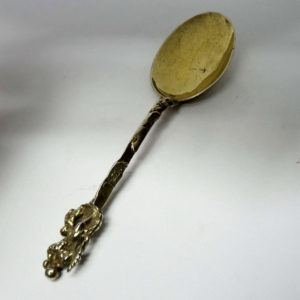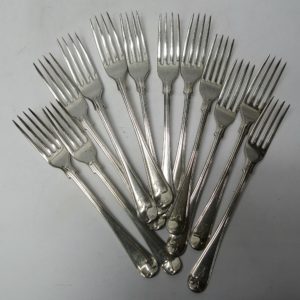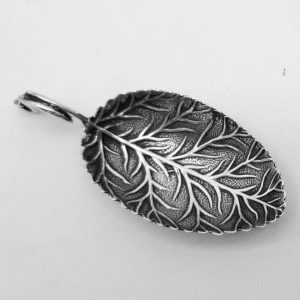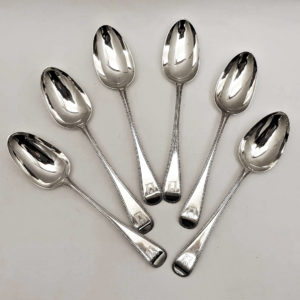Spoons & Forks
Spoons & Forks
Collectors Spoons, Dessert , Dinner Spoons, Soup and Serving Spoons
Tea, Coffee, Salt and Mustard Spoons, Caddy Spoons, Marrow Spoons, Mote Spoons
Browse our collection of antique sterling silver spoons and forks. These have a very practical purpose on the dinner table and also create a satisfying collecting field with their variety of fascinating designs and uses.
Spoons. Before the 18th century the only items of table silver made in any quantity were spoons. Early English silver spoons can date from as early as the 15th century and are highly collectible, especially spoons by rare makers and from unusual provincial towns. The most popular form of cast terminal was the seal top spoon, named after the circular disc at the top, which often bore the engraved initials of the owners. Lion sejant spoons and apostle spoons were also common from the 15th century to the beginning of the 17th century. From the late 16th century the plain flattened stem of the slip top spoon was introduced which developed during the 17th century into the popular trefid form.
Forks. Silver Dinner and Dessert Forks are rare before the 18th century and are not often found in sets until the late 1700s.
The Sucket Fork is an implement with a teaspoon bowl at one end and a two pronged fork at the other. Very rare and only produced from the late 17th century until the early 18th century.
-


Circa 1728
Abraham Marshoorn
8965 Antique Silver Spoon
An excellent antique Dutch gilt silver spoon. Cast silver. The finial is modelled with a seated figure holding a baby and accompanied by a cherub, an allegorical representation of maternal love. The back of the bowl is inscribed with the owners initials. Weight 61 grams, just under 3 troy ounces. Length 18.3 cms. Bowl measures 7×5 cms. Amsterdam, Netherlands. 1728.
-


1795
Thomas Wallis I
9088 Antique Silver Forks
Sold
A set of Georgian sterling silver dinner forks for 12 people. In the traditional Old English and thread pattern. All with a hand engraved stag crest. Weight approx 800 grams, 25.7 troy ounces. Length 21cm. London 1795. Maker Thomas Wallis. These match the dinner forks in #9078 Georgian canteen of cutlery.
-


Circa 1800
Joseph Taylor
9856 George III Silver Caddy Spoon
A charming little antique silver spoon with wire scroll handle, the bowl fashioned as a leaf. Weight 8 grams. Length 7cm. Width 3cm. Lion mark only. This type of spoon was generally made in Birmingham. Maker probably Joseph Taylor. Circa 1800.
-


1878
Henry Holland
7971 Antique Silver Serving Spoons
Sold
A superb set of 6 antique sterling silver spoons in the elegant bead pattern. Excellent plain style. Each piece has a hand engraved crest. Total weight, 6 spoons, 435 grams, 13.9 troy oz. Length 22.5cm. London 1878. Maker Henry Holland.